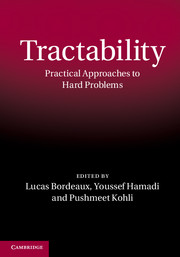12 - SAT Solvers
from Part 5 - Heuristics
Published online by Cambridge University Press: 05 February 2014
Summary
Boolean Satisfiability (SAT) can be considered a success story of Computer Science. Since the mid-90s, SAT has evolved from a decision problem with theoretical interest, to a problem with key practical benefits, finding a wide range of practical applications. From the early 60s until the mid 90s, existing SAT solvers were able to solve small instances with few tens of variables and hundreds of clauses. In contrast, modern SAT solvers are able to solve practical instances with hundreds of thousands of variables and millions of clauses. This chapter describes the techniques that are implemented in SAT solvers aiming to explain why SAT solvers work (so well) in practice. These techniques range from efficient search techniques to dedicated data structures, among others. Whereas some techniques are commonly implemented in modern SAT solvers, some others are more speciic in the sense that only some instances beneit from its implementation. Furthermore, a tentative glimpse of the future is presented.
Introduction
Boolean Satisfiability (SAT) is an NP-complete decision problem [14]. SAT was the first problem to be shown NP-complete. There are no known polynomial time algorithms for SAT. Moreover, it is believed that any algorithm that solves SAT is exponential in the number of variables, in the worst-case.
Although SAT is in theory an NP-complete problem, in practice it can be seen as a success story of Computer Science. There have been remarkable improvements since the mid 90s, namely clause learning and unique implication points (UIPs) [43], search restarts [15, 26], lazy data structures [48], adaptive branching heuristics [48], clause minimization [59] and preprocessing [18].
- Type
- Chapter
- Information
- TractabilityPractical Approaches to Hard Problems, pp. 331 - 349Publisher: Cambridge University PressPrint publication year: 2014
- 1
- Cited by



